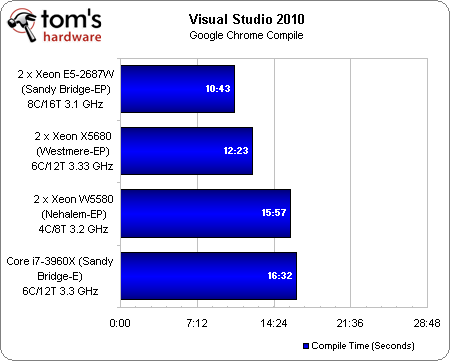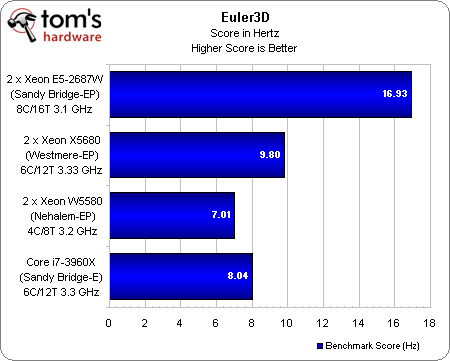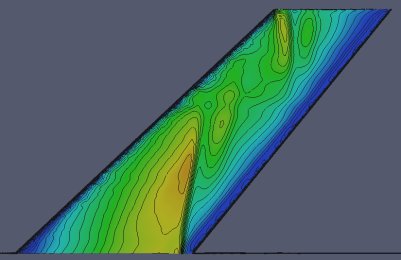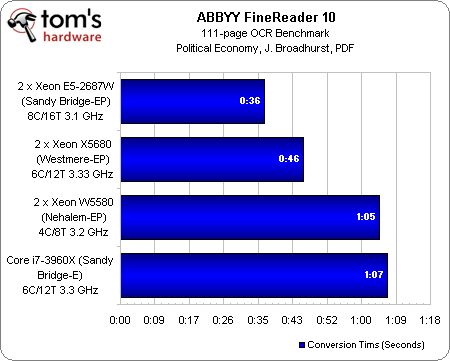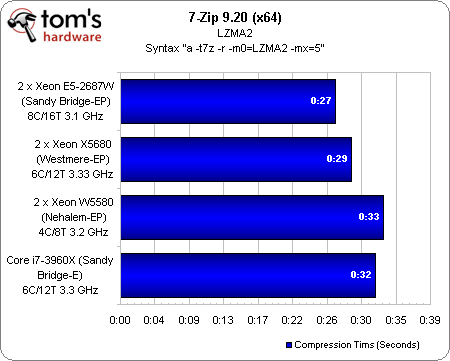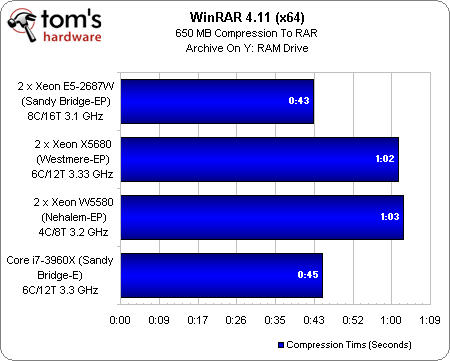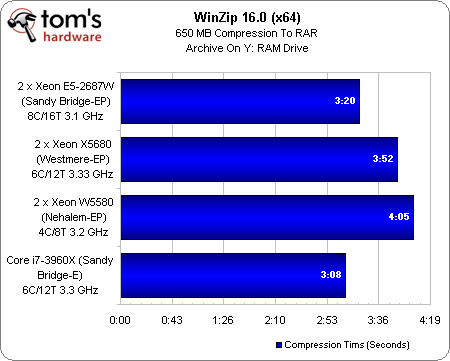Intel Xeon E5-2600: Doing Damage With Two Eight-Core CPUs
Intel's vaunted Sandy Bridge architecture has finally made its way to the company's dual- and quad-socket-capable Xeon processors. We got our hands on a pair of eight-core Xeon E5-2687W CPUs to compare against the older Xeon 5600- and 5500-series chips.
Benchmark Results: Productivity
We also made a big change to our Visual Studio 2010 benchmark in anticipation of today’s launch. Gone is the Miranda IM client compile workload. In its place, we’re compiling Google Chrome—a task that takes more than 10 minutes with 16 cores at 100% utilization.
As with some of the benchmarks on the previous page, the biggest performance improvement happens between Intel’s Xeon 5500 and 5600 processors. Nevertheless, the new Xeon E5s serve up a significant boost as well.
Based on the STARS Euler3D computational fluid dynamics production code, Euler3D’s workload is described as follows:
“The benchmark testcase is the AGARD 445.6 aeroelastic test wing. The wing uses a NACA 65A004 airfoil section and has a panel aspect ratio of 1.65, a taper ratio of 0.66, and a 45 degree quarter-chord sweep angle. This AGARD wing was tested at the NASA Langley Research Center in the 16-foot Transonic Dynamics Tunnel and is a standard aeroelastic test case used for validation of unsteady, compressible CFD codes…The benchmark CFD grid contains 1.23 million tetrahedral elements and 223 thousand nodes. The benchmark executable advances the Mach 0.50 AGARD flow solution. Our benchmark score is reported as a CFD cycle frequency in Hertz.”
Euler3D reports that it recognizes and employs all 32 of the Xeon E5 system’s available threads, and the result is a score that blows away the Xeon X5680s. Based on the fact that Core i7-3960X beats two Xeon 5500s and comes close to the 5600s suggests a big advantage from Sandy Bridge-based CPUs.
The rest of our productivity-oriented tests are decidedly less workstation-specific, though ABBYY’s FineReader 10 OCR app does a better job of taxing two Xeon E5s than video workloads like Adobe After Effects.
FineReader 10 shows Intel’s Core i7-3960X nearly matching two Xeon W5580s. A pair of Xeon X5680s yield a sizable 29% speed-up, while the Xeon E5s improve 21% compared to the 5600s.
Get Tom's Hardware's best news and in-depth reviews, straight to your inbox.
None of our compression workloads are able to fully utilize these workstation-oriented configurations. 7-Zip comes the closest, yielding a slight advantage to the Xeon E5s over the 5600s and 5500s. However, even a six-core Core i7 is fast enough to pass the Xeon 5500s.
Because WinRAR employs fewer threads than a Core i7-3960X offers to it, anything in excess (read: every two-chip platform) goes unused, resulting in a performance chart defined by architecture and clock rate. Clearly, Intel’s Sandy Bridge design is favored over Nehalem, which is why the Xeon E5s and Core i7 excel.
The i7 actually scores a win in WinZip 16. We’ve been critical of single-threaded versions of this software in the past, which always took significantly longer than similar tasks in WinRAR or 7-Zip. A move to WinZip 16 makes this a 64-bit app that shows activity on four cores. But it’s still way slower than our other compression tests. Low utilization suggests that the Core i7 is enjoying a higher Turbo Boost multiplier, giving it the edge over Xeon E5.
Current page: Benchmark Results: Productivity
Prev Page Benchmark Results: Rendering Next Page Percent Faster: Xeon E5s Vs. Xeon 5600s-
CaedenV My brain cannot comprehend what CS5 would look like with this combined with a 1TB R4 drive, and the GTX680 version of the Quatro would look like... and I am sure my wallet cannot!Reply
Great article! I was not expecting my mind to be blown away today, and it was :) -
dalethepcman No gaming benchmarks? I know this is a high workstation / mid server build, but you know some of the boutiques will make a gaming rig out of any platform. Just out of curiosity, I would have liked to see 2x7970 or 2x580 and a few gaming benchmarks thrown in. :)Reply -
willard dalethepcmanNo gaming benchmarks? I know this is a high workstation / mid server build, but you know some of the boutiques will make a gaming rig out of any platform. Just out of curiosity, I would have liked to see 2x7970 or 2x580 and a few gaming benchmarks thrown in.I'd be really surprised to see these in gaming machines, even in the high end boutiques. That's a $2k processor they reviewed, and basically all it offers over the $1k SB-E chip (for gamers) is an extra pair of cores, which games can't make use of.Reply -
reclusiveorc I wonder how fast TempEncode would chew thru transcoding avi/wmv files to mp3/mp4Reply -
willard esreverwhy aren't AMD cpus tested too? I wouldn't mind seeing how 2x interlagos stacks up.Anandtech benched those next to the new Xeons. Went about as well as Bulldozer vs. Sandy Bridge.Reply
http://www.anandtech.com/show/5553/the-xeon-e52600-dual-sandybridge-for-servers/6 -
cangelini esreverwhy aren't AMD cpus tested too? I wouldn't mind seeing how 2x interlagos stacks up.Mentioned on the test page--I've invited them to send hardware and they haven't moved on it yet.Reply -
willard cangeliniMentioned on the test page--I've invited them to send hardware and they haven't moved on it yet.I would guess that's because Interlagos is garbage compared to the new Xeons and they know it. I don't think they're terribly eager for the front page of Tom's Hardware to show the low end Xeon's beating the best Interlagos has to offer.Reply -
Onus What, or who, was the target? Are there military applications for this weapon?Reply
Sorry, vote me down all you like, but the title was just silly.
